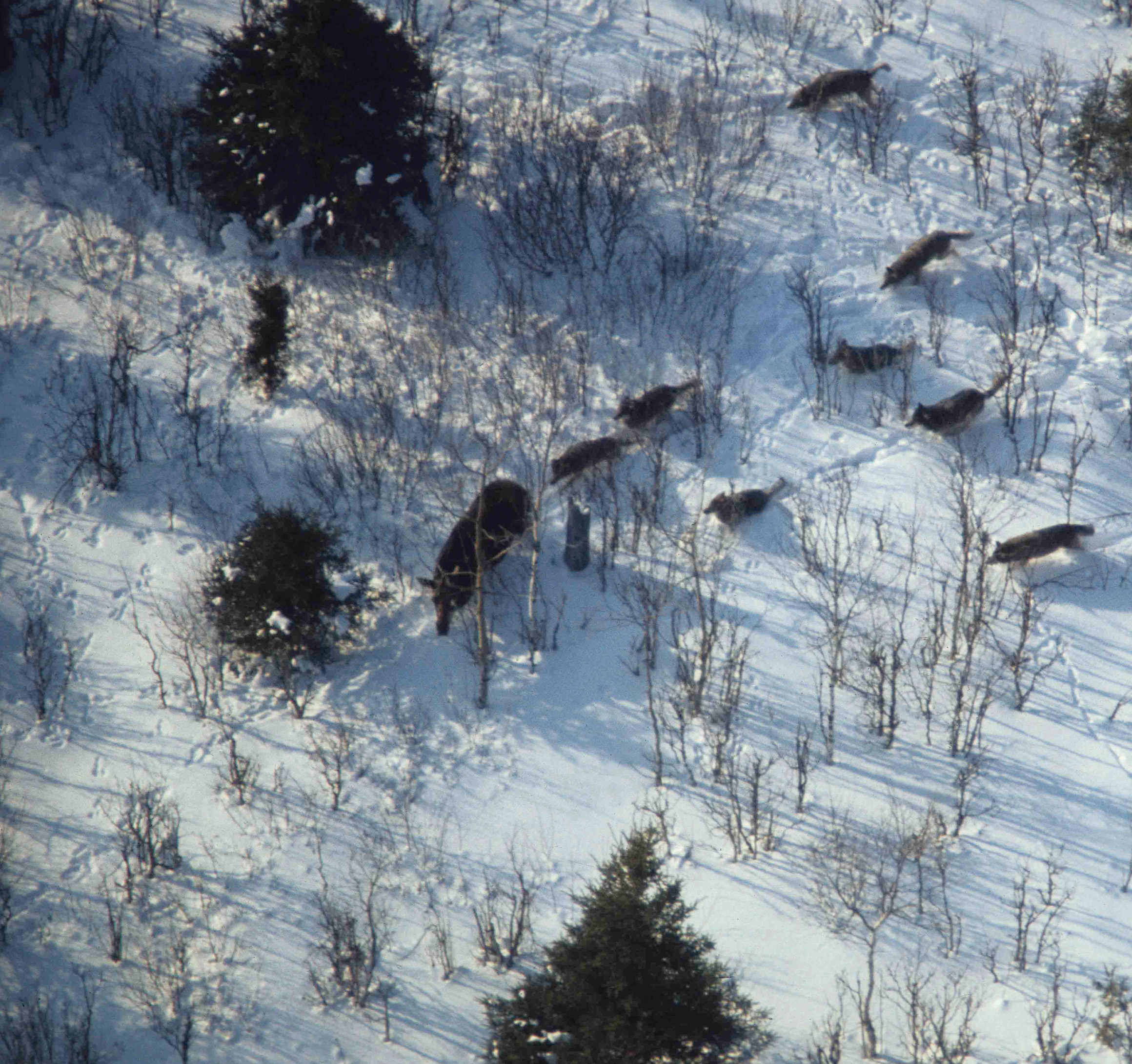Chapter 13
Population Dynamics over Space and Time
294

295
CHAPTER CONCEPTS
- Populations fluctuate naturally over time.
- Density dependence with time delays can cause populations to be inherently cyclic.
- Chance events can cause small populations to go extinct.
- Metapopulations are composed of subpopulations that can experience independent population dynamics across space.
Monitoring Moose in Michigan
Isle Royale, which is part of the state of Michigan and located off the northern shore of Lake Superior, has long served as a natural laboratory for ecologists. In the early 1900s, the island was colonized by moose from the mainland. This unlikely feat probably occurred during winter when the lake was frozen and the moose could travel the 40 km from the shores of the province of Ontario in Canada. The moose found an abundance of food on the island, and during subsequent decades the population grew rapidly. For more than 100 years, ecologists have watched the number of moose fluctuate widely due to changes in food, predators, and pathogens.
The initial changes in the population size of moose were driven by changes in the abundance of food. The population grew to approximately 3,000 animals by the early 1930s but in 1934, when the population finally exceeded the island’s carrying capacity, the moose suffered starvation and many died. In 1936 the island experienced extensive forest fires that stimulated new plant growth and, as a result, the moose population began to increase. By the late 1940s, the moose once again exceeded their carrying capacity and experienced another decline due to starvation.
“For more than 100 years, ecologists have watched the number of moose fluctuate widely due to changes in food, predators, and pathogens.”
The population would probably have continued this cycle of growth and decline, but sometime in the late 1940s gray wolves (Canis lupus) arrived on Isle Royale by crossing the ice during the winter. Beginning in 1958, ecologist David Mech and his colleagues began estimating the number of moose and the number of wolves on the island. This was a unique research opportunity. Because both immigration and emigration of the wolves and moose were extremely rare, the researchers could watch the dynamics of the two populations unfold over time. They have estimated the wolf and moose populations every year since 1958 and have continued to make new discoveries.
During the 1960s and early 1970s, there were about 24 wolves on the island while the moose population increased from about 600 to 1,500. In the 1970s, there was a series of winters with deep snow that made it difficult for the moose to move around and locate food. At this time the population of wolves grew to 50 animals. These two factors caused a sharp drop in the moose population.
In 1981, a lethal virus (canine parvovirus) arrived on the island, probably carried to the island by a visitor’s domestic dog. The virus caused the wolf population to experience a major decline, dropping from approximately 50 to 14 animals. With fewer wolves on the island, the moose population rebounded and it continued to grow. In 1996, the moose once again exceeded their carrying capacity and experienced widespread starvation, causing the population to drop from approximately 2,400 to 500 individuals. From 1997 to 2011, the number of moose has fluctuated between 500 and 1,000 while the number of wolves has fluctuated between 15 and 30.
296
The story of the moose and wolf populations on Isle Royale during the past 100 years highlights the fact that populations in nature often experience large fluctuations in size. These fluctuations can have many different causes that operate either separately or together. In this chapter, we will examine how populations fluctuate over space and time. Understanding the causes of such fluctuations can help us understand the natural fluctuations of organisms in nature so we are able to predict the future abundances of populations and the species with which they interact.
SOURCES: R. O. Peterson, Wolf-moose interaction on Isle Royale: The end of natural regulation? Ecological Applications 9 (1999): 10–16.
J. A. Vucetich and R. O. Peterson, The influence of top-down, bottom-up and abiotic factors on the moose (Alces alces) population of Isle Royale, Proceedings of the Royal Society of London-Series B 271 (2004): 183–189.
J. A. Vucetich and R. O. Peterson, Ecological Studies of Wolves on Isle Royale: Annual Report 2010–2011, School of Forest Resources and Environmental Science, Michigan Technological University, 2011.
 In the previous chapter, we saw that populations can be regulated by density-dependent and density-independent factors. In this chapter, we look at the causes of variation in population size, an issue that has become increasingly relevant as many species dwindle toward extinction and human activities fragment habitats into ever smaller, more isolated patches. Because these fluctuations include both random and cyclical changes over time, we will incorporate them into population models. We will also investigate how population fluctuations can cause small populations to be more prone to extinction. With this understanding of population variation over time, we will move on to examine population fluctuations over space by expanding our discussion of metapopulations from Chapter 12 to include metapopulation models and current research in metapopulations.
In the previous chapter, we saw that populations can be regulated by density-dependent and density-independent factors. In this chapter, we look at the causes of variation in population size, an issue that has become increasingly relevant as many species dwindle toward extinction and human activities fragment habitats into ever smaller, more isolated patches. Because these fluctuations include both random and cyclical changes over time, we will incorporate them into population models. We will also investigate how population fluctuations can cause small populations to be more prone to extinction. With this understanding of population variation over time, we will move on to examine population fluctuations over space by expanding our discussion of metapopulations from Chapter 12 to include metapopulation models and current research in metapopulations.